Carin, Cari, Cārin, Cārī, Carī: 34 definitions
Introduction:
Carin means something in Buddhism, Pali, Hinduism, Sanskrit, Jainism, Prakrit, the history of ancient India, Marathi, Hindi, biology, Tamil. If you want to know the exact meaning, history, etymology or English translation of this term then check out the descriptions on this page. Add your comment or reference to a book if you want to contribute to this summary article.
Carin has 30 English definitions available.
Alternative spellings of this word include Chari.
Images (photo gallery)
(+112 more images available)
Languages of India and abroad
Sanskrit dictionary
[Deutsch Wörterbuch]
Source: Cologne Digital Sanskrit Dictionaries: Böhtlingk and Roth Grosses Petersburger WörterbuchCari (चरि):—(von car) m. Thier [Hemacandra’s Abhidhānacintāmaṇi 1216.]
--- OR ---
Cari (चरि):—[Uṇādisūtra 4, 139.] [Trikāṇḍaśeṣa 2, 9, 27.]
Source: Cologne Digital Sanskrit Dictionaries: Böhtlingk and Roth Grosses Petersburger WörterbuchCārin (चारिन्):—(von 1. car)
1) adj. a) beweglich: (lokeṣu) saṃsthāsnucāriṣu [Mahābhārata 7, 372.] — b) am Ende eines comp.: α) sich bewegend, herumgehend, umherwandelnd, lebend, sich aufhaltend: bhūmi [Indralokāgamana 1, 31.] yā preṣyāntaḥpuracāriṇī [Amarakoṣa 2, 6, 1, 18.] śarīrāntara [Hiḍimbavadha 4, 4.] preta, bhūta [Mahābhārata 13, 1163.] prāṇāpānau nāsābhyantaracāriṇau [Bhagavadgītā 5, 27.] (bhūtānām) sarvāntaścāriṇām [Kathāsaritsāgara 5, 25.] atra [Rāmāyaṇa 3, 58, 10.] araṇya [Pañcatantra 69, 1.] grāmāraṇyāmbuvyomadyuniśobhaya [Varāhamihira’s Bṛhajjātaka S. 85, 6.] svakālotkrama [87, 2.] ugra [Bhāgavatapurāṇa 5, 22, 8.] abhīta [Rāmāyaṇa 5, 37, 39.] gūḍha [Raghuvaṃśa 19, 33.] pāda auf Füssen gehend [Bhāgavatapurāṇa 6, 4, 9.] pucchāsya [Suśruta 1, 207, 3.] nimeṣāntara in einem Augenblick sich wohin verfügend, zu einem Gange nur eines Augenblickes bedürfend [Mahābhārata] in [Benfey’ Chrestomathie aus Sanskritwerken 62, 52.] [Harivaṃśa 9139.] Vgl. ambu, eka, kha, giri, go, jala, divi, naktaṃ, madhya, vana . — β) handelnd, zu Werke gehend; übend, thuend: pracchanna [Rāmāyaṇa 3, 51, 26.] pāpa, śubha [Mahābhārata 14, 759.] [Pañcatantra 227, 22.] duṣṭa [Rāmāyaṇa 2, 74, 2. 3, 55, 42.] [Vetālapañcaviṃśati 21, 7.] duḥkha [Rāmāyaṇa 3, 23, 14.] Vgl. dharma, bahu, brahma, vrata, svacchanda . — γ) lebend von: dhānya [Suśruta 1, 208, 12.] —
2) m. Fusssoldat: anvaśvaṃ daśa dhānuṣkā dhānuṣke sapta cāriṇaḥ [Mahābhārata 6, 3545.] —
3) f. cāriṇī Name einer Pflanze (karuṇī) [Rājanirghaṇṭa im Śabdakalpadruma]
--- OR ---
Cārin (चारिन्):—
1) b) β) siṃhavikrānta [Spr. 3015.] svecchā [SARVADARŚANAS. 79, 19.] — δ) nahekommend, ähnlich in padmacāriṇī; vgl. padmāṭa .
--- OR ---
Cārin (चारिन्):—
1) a) die richtige Lesart ist sasthāsnucāriṣu .
Source: Cologne Digital Sanskrit Dictionaries: Sanskrit-Wörterbuch in kürzerer FassungCari (चरि):—m. Thier.
Source: Cologne Digital Sanskrit Dictionaries: Sanskrit-Wörterbuch in kürzerer FassungCārin (चारिन्):——
1) Adj. — a) beweglich , sich bewegend. — b) am Ende eines Comp. — α) sich bewegend — , herumgehend — , umherwandelnd — , lebend — , sich aufhaltend in oder auf. — β) verfahrend , zu Werke gehend. — γ) übend , thuend. — δ) lebend von. — ε) nahekommend , ähnlich. —
2) m. — a) Fusssoldat. — b) Späher , Kundschafter [Āpastamba’s Dharmasūtra] —
3) *f. ṇī eine best. Pflanze [Rājan 10,107.]
Sanskrit, also spelled संस्कृतम् (saṃskṛtam), is an ancient language of India commonly seen as the grandmother of the Indo-European language family (even English!). Closely allied with Prakrit and Pali, Sanskrit is more exhaustive in both grammar and terms and has the most extensive collection of literature in the world, greatly surpassing its sister-languages Greek and Latin.
See also (Relevant definitions)
Starts with: Carinangra, Carinda, Caringua, Carini, Carinu.
Ends with (+166): Abhicarin, Abhisamcarin, Abhisancarin, Abhyantaracarin, Abhyudacarin, Acaracarin, Acarin, Adharmacarin, Adharmmacarin, Agucarin, Ajna-sancarin, Akasacarin, Akashasamcarin, Akashavyabhicarin, Akhandacarin, Ambaracarin, Ambucarin, Anacarin, Aniketacarin, Anishucarin.
Full-text (+697): Shari, Sahacarin, Alata, Carivac, Atikranta, Dandapada, Gudhacarin, Ekacarin, Lalitasancara, Edakakridita, Adhyardha, Shakatasya, Vicitra, Kamacarin, Vyomacaripura, Vihrita, Parshvakranta, Caripati, Vratacarita, Kakanacari.
Relevant text
Search found 70 books and stories containing Carin, Cari, Cārī, Carī, Cāri, Cārin, Chari, Saari, Sari; (plurals include: Carins, Caris, Cārīs, Carīs, Cāris, Cārins, Charis, Saaris, Saris). You can also click to the full overview containing English textual excerpts. Below are direct links for the most relevant articles:
Natyashastra (English) (by Bharata-muni)
Gati in Theory and Practice (by Dr. Sujatha Mohan)
Performance of Cārī < [Chapter 2 - Concept and technique of Gati]
Gati, as found in classical theatres of Kūḍiāṭṭam < [Chapter 4 - Practice of Gati]
Gati in Nāṭyaśāstra with explanations from Abhinavabhāratī < [Chapter 2 - Concept and technique of Gati]
Vishnudharmottara Purana (Art and Architecture) (by Bhagyashree Sarma)
2.4. Cārī (delicate movements of limbs) < [Chapter 3 - Drama and Dance]
Dance Traditions of South India < [January-February 1935]
The First Widow Marriage < [October 1970]
Aboriginal Women’s Speechless Communication < [October – December, 2005]
Bhakti-rasamrta-sindhu (by Śrīla Rūpa Gosvāmī)
Śrī Kṛṣṇa-vijaya (by Śrī Gunaraja Khan)
Related products






